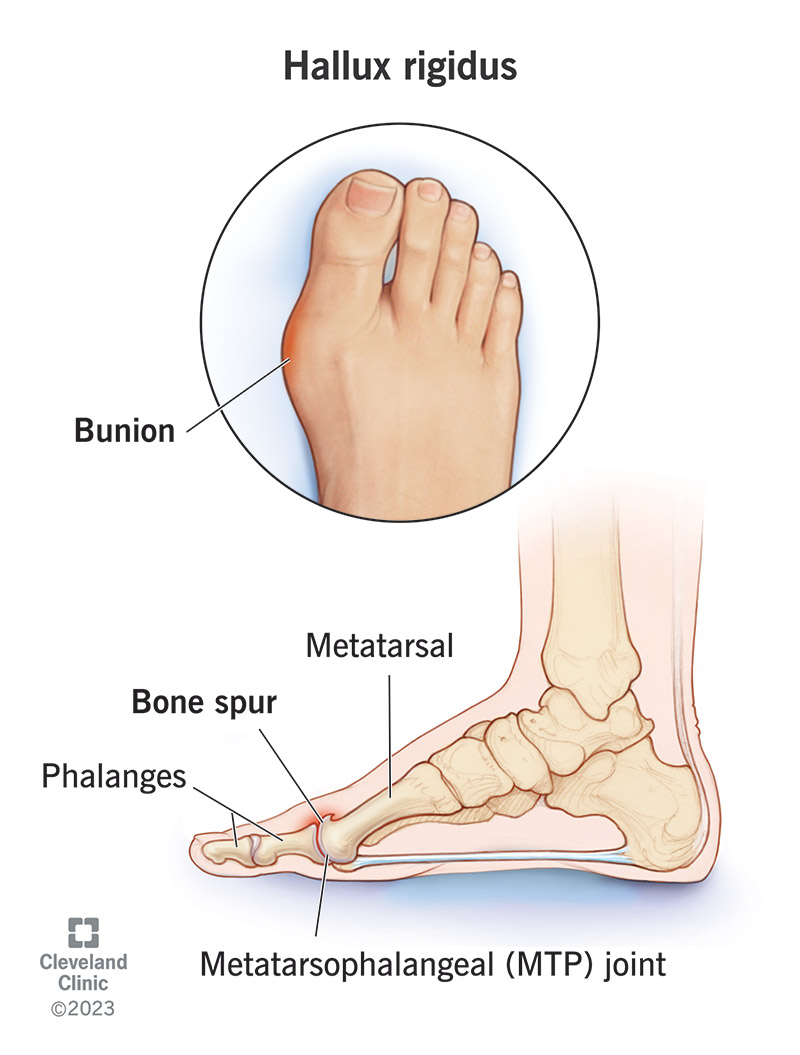Hallux rigidus is a type of arthritis that affects the joint where your big toe meets your foot. Most people can manage their symptoms with nonsurgical treatments, like over-the-counter pain relievers and wearing better-fitting shoes. You might need surgery if the pain and stiffness affect your ability to participate in your daily activities.

Hallux rigidus is a type of arthritis in your big toe. Specifically, it affects your big toe joint — the metatarsophalangeal (MTP) joint. Your MTP joint is where the base of your big toe meets your foot.
“Arthritis” is a general term for a group of more than 100 diseases. It causes inflammation (swelling) in and around your joints. Healthcare providers sometimes call hallux rigidus “big toe arthritis.”
Hallux rigidus means “stiff big toe” — the condition’s most common symptom. It causes pain and stiffness in your MTP joint. It’s a form of osteoarthritis (“wear and tear arthritis”).
Visit a healthcare provider if you’re experiencing symptoms like pain, stiffness or swelling in your big toe or foot.
Experts estimate that around 1 in 40 adults older than 50 have hallux rigidus. It’s the most common type of foot arthritis.
Hallux rigidus is the second most common MTP joint condition after bunions (hallux valgus).
Cleveland Clinic is a non-profit academic medical center. Advertising on our site helps support our mission. We do not endorse non-Cleveland Clinic products or services. Policy
The most common hallux rigidus symptoms include:
Some activities or conditions might make your symptoms worse, including:
Most cases of hallux rigidus develop naturally over time without an obvious cause. As you age, normal wear and tear on your joints can add up to damage the cartilage that cushions them. This wear and tear is usually what causes hallux rigidus (and other forms of osteoarthritis).
Hallux rigidus likely develops because your big toe joint experiences a lot of stress when you walk. Every step you take places a force equal to twice your body weight on the MTP joint.
Other causes of hallux rigidus include:
Anyone can develop hallux rigidus, but it’s more common in certain groups of people, including:
Certain health conditions can make you more likely to develop hallux rigidus, including:
A healthcare provider will diagnose hallux rigidus with a physical exam. They’ll test your toe joint’s range of motion and check how far you can bend your toe up and down. You might need to visit a podiatrist — a healthcare provider who specializes in taking care of your feet.
Your provider might use a foot X-ray to take pictures of your foot and check for bone spurs.
Your provider might classify hallux rigidus with a grade based on how much it affects your ability to move your big toe. They might call these grades stages if your symptoms are getting more severe over time. Hallux rigidus grades include:
Which treatment you’ll need depends on the severity of your symptoms and what caused hallux rigidus. Your provider might suggest:
Most people don’t need surgery to treat hallux rigidus. Your provider might suggest surgery if other treatments don’t relieve your symptoms, or if the hallux rigidus makes it hard (or impossible) to participate in your daily routine.
Surgical procedures for hallux rigidus include:
Complications from hallux rigidus surgery are rare, but they can happen. The most common complications include:
How long it takes to recover depends on which treatments you need and how severe the hallux rigidus is. Treatments like switching shoes and wearing toe pads might be all you need to relieve your symptoms. If that’s the case, you should be able to return to your usual routine as soon as your provider says it’s safe.
If you need hallux rigidus surgery, your recovery time will depend on which procedure your surgeon performed:
You probably can’t prevent hallux rigidus from developing, but you may be able to slow down its progression if you:
With the right treatment, you can reduce pain and inflammation so you can get back to your usual activities. Some hallux rigidus surgeries may leave you with a limited ability to bend your toe, but you can still be active. Your provider or surgeon will tell you what to expect, and which activities to avoid.
Surgery is usually the only way to permanently get rid of hallux rigidus. But most people with hallux rigidus are able to find a combination of nonsurgical treatments that manage their symptoms.
Visit a healthcare provider or podiatrist as soon as you notice new pain in or around your big toe joint. They’ll diagnose what’s causing the pain and any other symptoms you’re experiencing and will suggest treatments to relieve them.
Not necessarily. You might be more likely to develop hallux rigidus in your other foot. But having hallux rigidus doesn’t increase your odds of having arthritis in other joints throughout your body.
A note from Cleveland Clinic
If you have big toe joint pain, talk to your healthcare provider. The earlier they diagnose hallux rigidus, the more successful treatment can be. Most people only need nonsurgical treatments to manage their symptoms. But if lingering pain interferes with your life, surgery can help. There are several hallux rigidus surgery options. Your provider and surgeon will discuss your options with you and help you decide which treatment is right for you.
Last reviewed by a Cleveland Clinic medical professional on 05/23/2023.
Learn more about our editorial process.
Cleveland Clinic is a non-profit academic medical center. Advertising on our site helps support our mission. We do not endorse non-Cleveland Clinic products or services. Policy